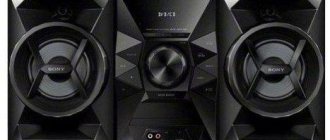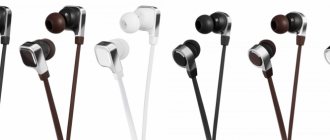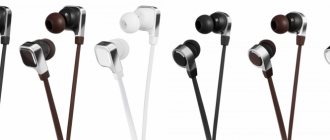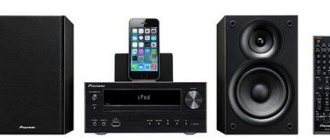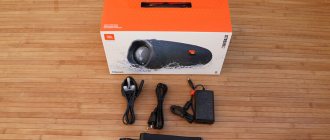Numerous motorists constantly turn to the review of such a device as 3-component car acoustics in order to purchase equipment that will work for a long time and without interruption. At the same time, true connoisseurs of high-quality sound are constantly improving the sound quality in a 16 cm bandpass acoustic or other system.
Car acoustics
Three-component acoustic systems such as Focal, Hertz, Pride Wild Sould 165.3 require special attention, however, before installing them on your vehicle, it is worth understanding all the advantages and disadvantages of each of them.
The car connection diagram deserves special attention, since it will be easier to do this procedure yourself than to pay specialists.
↑ Reincarnation of the cabinet into a three-way column
The idea to assemble the speaker myself was born a long time ago, but there was neither time nor opportunity.
Finally getting ready, I decided it was time. Before that I had experience in subwoofer manufacturing. The material used was chipboard 20 mm thick. To do this, a cabinet and a couple of shelves were sent for recycling. Everything was cut out with a jigsaw at school (thanks to the students of grade 9 “B”). Dimensions: 850×170×260 mm. The low-frequency section is separated by a partition and the resulting volume of the low-frequency section turned out to be 35 liters.
The bass reflex is set to 45 Hz (I wanted it lower, but the FI was needed too long for the dimensions of the speaker), the photo shows a general view of what happened.
From the inside, everything is reinforced with 20x20 timber, which is mounted on PVA, and everything is coated with sealant. The outside of the speakers are puttied and covered with veneer (don’t be harsh, I glued veneer for the first time, the jambs are visible). Next I plan to glue the corners (there are chips in the veneer) and varnish them.
↑ Speakers for speakers
The speakers for the speakers were chosen from what was: LF - from music.
Aiwa center (plastic frame, paper diffuser with rubber suspension, power 15 W). MF - 10GDN-1-4 (6GD-6), a good speaker (a pair was mercilessly removed from the Elegy 101 stereo speakers).
HF - 6GDV-6-16, with it everything turned out not so simple. At first I wanted to use the Chinese noname, but then I came across HF heads from AS-70 from Radiotekhnika (6GDV-6-16). I gave them away to a friend who knew about my hobby (when asked where the rest went, he said that he gave them to others, but no one needed the HF... oh, I should have been wary then).
Corrections were made and a hole was cut through the HF speaker, then it began... I decided to measure their resistance in order to calculate the total resistance of the speaker, but the speakers showed no signs of life, the autopsy showed that the patient was given a lethal dose of power - the heart could not stand it... I mean, the coil ( the frame was charred in several places).
Installation of three-way acoustics
What will we install?
Three-way car audio consists of three types of speakers:
- The largest in diameter is the midbass, a low-frequency speaker operating in the range from 70 to 200–500 Hz.
- The compact midrange speaker reproduces sound in the range from 200–500 to 6–7 thousand hertz. It carries the main “information” load, for this reason its sensitivity is important - it should be within 92-93 dB. These two types of speakers are usually combined into one in a two-way system.
- The third type of speaker is a high-frequency speaker (tweeter), operating in the range from 1-1.5 to 20-30 thousand hertz. These speakers must also have high sensitivity to ensure the sound does not distort.
An important component of three-way acoustics is the crossover; its task is to divide the supplied sound signal and supply the speaker with the frequencies for which it is intended. For example, if the entire frequency range is fed to the tweeter, the sound picture will be spoiled; if the signal has high power and the speaker has good sensitivity, then the tweeter will simply burn out.
The advantage of a three-way system is good predictability of sound direction, higher power and lack of distortion at high volumes.
Where are the speakers of a three-way system installed?
The task of installing 6 speakers is more difficult than installing 4 speakers. The compact size of the midrange makes the task a little easier; it does not require such an impressive volumetric design as the midbass. For some systems, it is enough to find just a liter of free space and you can begin installation.
Where is midrage installed? — The following locations are suitable for this speaker:
- next to the woofer with a slight turn towards the listener;
- at the top of the door;
- torpedo;
- front pillar, if it is wide enough.
The tweeter is installed either instead of the standard speaker, or a place is selected for it on the top of the door, in the rack or on the front panel. It is advisable that it be in the same vertical position as the subwoofer.
To install the midbass, the standard location for installing the front speaker with a diameter of 16 cm in the car door is traditionally chosen. As an alternative, you can use kick panels, space under the front seats, or a dashboard. Regardless of the placement location, the seat for the woofer should be rigid; this will help get rid of resonance, which will add a negative color to the overall picture. It is also important to get rid of vibrations of adjacent planes; vibration isolating materials are used for this.
The optimal installation option: midbass and midrange - in the doors, and tweeters - in the A-pillar. The tweeter can be directed either into the interior or onto the glass. It is not recommended to install a three-way speaker system in the rear doors; it will be like listening to a performer with his back turned to the stage.
An important condition that our studio masters fulfill is to prevent sound from the rear of the speaker from entering the overall sound picture. This phenomenon is called the “acoustic screen”; it causes a kind of short circuit when acoustic waves propagate, exact copies of the front ones, but with a different phase. The meeting of the two emissions results in silence, which distorts the high and mid frequencies. Inexperienced listeners may notice this only in the lower part of the sound range, but our specialists clearly hear distortions and prevent their occurrence due to proper isolation of rear radiation.
Where to install midbass and midrange in the doors? — If a large-diameter woofer does not cope well with reproducing the upper midrange, then it is better to install a midrange nearby. If the speaker performs well within the given frequency range, then you can raise it higher. Placing the speakers next to each other allows for better matching of frequency separation and sound level. It should be remembered that it is the midrange that is responsible for the formation of the stage and the sound of vocals; it is important to choose the correct direction of the emitter and avoid re-reflection. If necessary, our craftsmen use additional sound-absorbing materials in the interior, special films and dampers to solve this problem.
Stages of installing three-way acoustics
The preparatory stage for installing speakers is removing the door trim, assessing the availability of free space and the level of vibration insulation. Adding another speaker increases the level of vibration, so the quality of the vibration isolation coating will need to be improved. Our craftsmen carefully remove the door trim without damaging the decorative material and internal mechanisms. All installation work is carried out in several stages:
- Preparation of podiums: depending on the chosen location, the dimensions of the stands are calculated, which are necessary to minimize the phenomenon of resonance, and they are made of thick plywood in accordance with the diameter of the speakers and their directionality. Ordinary plywood is used, which is additionally treated with water-repellent compounds;
- A hole is cut out for the midrange, since, unlike the woofer, there is no standard location for it;
- Vibration insulation and sound insulation are installed, this cuts off external noise, makes the door heavier and resistant to sound waves, and eliminates squeaks. Modern vibration-isolating materials AeroPlus and Vibroplast Gold are used, and Bitoplast is used in the places where the speakers are installed;
- The tweeter is installed on/in the rack, the location is selected by an experienced craftsman who takes into account the volume of the cabin and the drawing of the scene;
- Cables are laid from the head unit, a high-quality cable with acoustic terminals is used, the path is selected through standard holes, and corrugation is used to protect the cable from mechanical damage. If there are no clips and standard holes, they must be installed; rubber bushings must be used to protect the cable from mechanical damage;
- Compensators are installed using double-sided tape;
- The podium with the speaker is installed, if necessary, additional gaskets are installed so that the speaker only protrudes slightly above the door trim.
At the final stage of work, the speakers are connected to the cables, and the polarity must be observed. The sheathing is installed in place and carefully adjusted. The functionality of the system is checked and the sound of the system is adjusted in accordance with your wishes. A professional tune-up is definitely needed, as the speakers located on the left side of the driver are too close, and those on the right side are further away. The uniformity of the sound stage can only be ensured through the use of special measures and professional equipment. A hardware and software complex is used that automatically adjusts the parameters of each channel using algorithms based on subjective listening.
The equipment analyzes the signal level, its spectral composition, and polarity in each channel. This allows you to adjust the frequency response taking into account the operation of low- and high-pass filters. The signal strength, distortion and interference of both analog and digital signals are checked. The use of scanners and noise analyzers, testers and an oscilloscope allows you not only to quickly set up three-way acoustics, but also to make them much better quality.
↑ Reanimation of the HF speaker
An emergency meeting was opened between me and my wife (thanks to her for understanding me), at which it was proposed to rewind the coils (I have a lot of experience, but not such speakers!).
First of all, I had to clean the coil frame from the remnants of the original wire. There were no wires of this thickness, and I had to wind a thicker one (which was found on one of the lying around boards from the radio), a mechanism was invented for winding (thanks to Trudovik from the same school, in secret - I teach computer science there twice a week), on it is visible in the photo, as well as the general creative process!!!
As for how I wound the wire, I don’t know; there was no micrometer then. I wound one turn to another in two layers. There were 70 turns in total. If the wire were thinner, I think it would be wound in three layers. Each layer was coated with Moment.
You see what happened. As a result, the resistance decreased to 4.5 Ohms.
What are 3-way component speakers?
It is worth noting that high-quality 3-component car acoustics is a combination of three main components:
- dynamics;
- crossover;
- diffuser
3-way component acoustics Kicx
At the same time, 3-component acoustics, including 16 cm band, are characterized by the power, sensitivity and impedance of the speakers. It is worth clarifying that 3-way component acoustics are characterized by the presence of three speakers capable of reproducing low, mid and high frequencies.
Hertz MPK 163.3 PRO acoustics 3-component
As a rule, the wiring diagram for strip-type acoustics is similar, but its execution varies.
↑ Photos of finished speakers
Updated on 11/04/2008.
Igor Kotov If you have any questions, write. Thank you for your attention!
